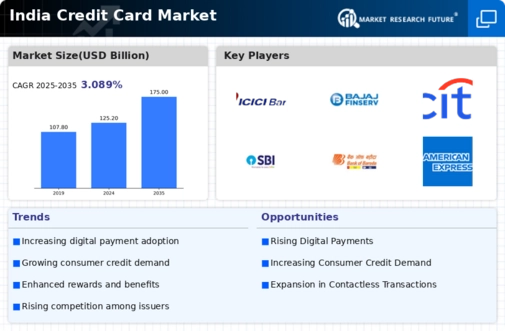Increased Focus on Customer Experience
In the competitive landscape of the credit card market, there is an increasing emphasis on enhancing customer experience. Financial institutions are recognizing that providing exceptional service is crucial for customer retention and acquisition. As of November 2025, surveys indicate that 70% of consumers prioritize customer service quality when choosing a credit card provider. This has prompted banks and fintech companies to invest in user-friendly interfaces, personalized services, and responsive customer support. Moreover, loyalty programs and rewards schemes are being tailored to meet the preferences of diverse consumer segments, thereby fostering brand loyalty. The focus on customer experience is likely to differentiate providers in the credit card market, as consumers gravitate towards institutions that offer not only competitive rates but also superior service.
Rising Consumer Demand for Credit Products
The credit card market in India experiences a notable surge in consumer demand, driven by an increasing middle-class population and rising disposable incomes. As more individuals seek to enhance their purchasing power, the credit card market is witnessing a significant uptick in new card applications. Data indicates that the number of credit cards in circulation has grown by approximately 20% over the past year, reflecting a shift in consumer behavior towards credit utilization. This trend is further supported by the growing acceptance of credit cards across various retail sectors, including e-commerce and travel, which enhances the overall attractiveness of credit products. Consequently, financial institutions are compelled to innovate and diversify their offerings to cater to this burgeoning demand, thereby shaping the competitive landscape of the credit card market.
Technological Advancements in Payment Systems
Technological innovations play a pivotal role in transforming the credit card market in India. The integration of contactless payment systems and mobile wallets has revolutionized the way consumers transact. As of November 2025, data suggests that contactless transactions account for over 30% of all credit card transactions, indicating a strong consumer preference for convenience and speed. Furthermore, advancements in artificial intelligence and machine learning are enhancing fraud detection and risk assessment processes, thereby increasing consumer confidence in credit card usage. Financial institutions are increasingly investing in technology to streamline operations and improve customer experiences, which is likely to drive further growth in the credit card market. This technological evolution not only benefits consumers but also positions financial institutions to better manage risks associated with credit lending.
Government Initiatives Promoting Digital Finance
The Indian government has implemented various initiatives aimed at promoting digital finance, which significantly impacts the credit card market. Programs such as Digital India and the push for a cashless economy have encouraged consumers to adopt credit cards as a preferred payment method. As of November 2025, the government reports a 25% increase in digital transactions, which correlates with the rising adoption of credit cards. Additionally, regulatory frameworks are being established to enhance transparency and security in financial transactions, further bolstering consumer trust in credit products. These initiatives not only facilitate greater financial inclusion but also stimulate competition among financial institutions, leading to innovative credit card offerings tailored to diverse consumer needs. The synergy between government policies and market dynamics is likely to sustain growth in the credit card market.
Emergence of Fintech Companies in Credit Services
The rise of fintech companies is reshaping the credit card market in India. These innovative firms are leveraging technology to offer streamlined credit services, often with more favorable terms than traditional banks. As of November 2025, fintechs account for approximately 15% of new credit card issuances, reflecting their growing influence in the market. Their ability to utilize data analytics for credit scoring and risk assessment allows for more inclusive lending practices, catering to underserved segments of the population. This disruption is compelling traditional financial institutions to adapt and innovate, leading to a more dynamic and competitive credit card market. The collaboration between fintechs and established banks is also becoming more common, suggesting a potential for hybrid models that could further enhance service delivery and customer satisfaction.


























Leave a Comment